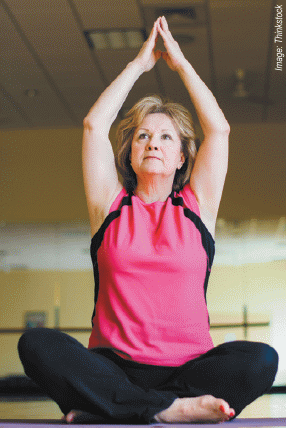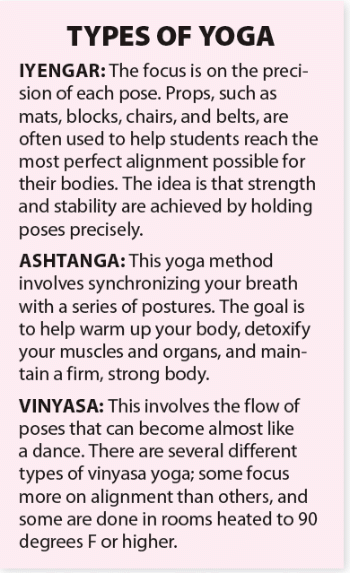Bored with Your Exercise Routine? Try Yoga
Yoga can help boost bone strength and improve
balance and flexibility
 If your exercise regimen needs some new life, consider an activity that helps improve strength, flexibility, and balance while also relieving stress. Yoga is an option for most people, because a routine can be specifically matched to your age, fitness level, and overall health. If your exercise regimen needs some new life, consider an activity that helps improve strength, flexibility, and balance while also relieving stress. Yoga is an option for most people, because a routine can be specifically matched to your age, fitness level, and overall health.
And if you're not especially active now, recovering from surgery, or coping with an illness, you can still start a yoga program, says orthopedic specialist Cara Ann Senicola, PT, DPT, with the Weill Cornell-affiliated Hospital for Special Surgery.
“Research shows that sedentary people who practice yoga have increased static (still) balance as well as dynamic (movement) balance,” she explains. “Yoga also helps increase flexibility, and it can be the perfect adjunct to rehabilitating any orthopedic injury.”
Studies also have found that people with depression see improvements in their condition after participation in yoga classes, Senicola adds.
Yoga basics
The first thing you should know about yoga is that it's not all about arching your back like an Olympic gymnast or twisting your limbs into pretzel-like knots. Certainly, advanced yoga practitioners can display some remarkable pliability. But beginners also can do a lot of stretching and moving in ways that are gentle and manageable, regardless of weight, age, and flexibility.
As an exercise regimen, yoga calls for holding different poses that involve stretching, strengthening, and balancing. Yoga students also learn to breathe properly while going through the various poses, Senicola says. Yoga also can include a meditative and even a spiritual component, but a basic yoga class will focus on the physical practice.
 There are several types of yoga (see sidebar, right). Some advanced classes involve a flow of poses (moving from one pose directly into another) that can make for a good workout, but Senicola recommends beginners start with a class in Iyengar yoga, named after B.K.S. Iyengar, a famous yoga instructor from India. There are several types of yoga (see sidebar, right). Some advanced classes involve a flow of poses (moving from one pose directly into another) that can make for a good workout, but Senicola recommends beginners start with a class in Iyengar yoga, named after B.K.S. Iyengar, a famous yoga instructor from India.
“There is no flow in Iyengar yoga, so you're not likely to sweat initially,” says Senicola. “Positions are clearly demonstrated, so they are easy to follow, and instructors can help guide you into perfect postural alignment. However, if you want a higher-intensity workout, you may prefer a more flow-type class, like ashtanga, or a vinyasa-style yoga.”
Yoga and bone strength
For postmenopausal women, yoga can be an especially effective tool to help prevent osteoporosis, Senicola says. Both weight-bearing and standing exercises help strengthen bones. The thoracic spine—the part of the backbone that connects to the ribs—is particularly vulnerable to fractures.
“Many exercises in yoga focus on lengthening the spine to improve posture,” Senicola says. “There are also exercises that strengthen the upper back muscles and stretch the front of the chest, which can help reduce the risk of stress fractures in the thoracic spine.”
Cautions
While yoga is right for just about anyone, there are some medical conditions that may limit what you can do. “Yoga practice often includes back bends and forward bends, so if you currently have an acute back injury, some positions might aggravate your symptoms. You should consult a medical specialist before initiating yoga practice,” Senicola explains.
If you are new to yoga, or you have an injury or a medical condition that may limit your movement, be sure to tell your instructor before starting a class. Poses can be modified to prevent further injury or other complications.
Getting started
To find a yoga class in your community, do an Internet search or check with local yoga studios, health clubs, and senior centers to see if beginner classes are available. Because yoga poses done incorrectly can lead to strains or injuries, Senicola strongly recommends taking a class from a certified yoga instructor. You may want to take a private class at first to get individual attention as you learn the fundamentals of yoga's many poses. | 